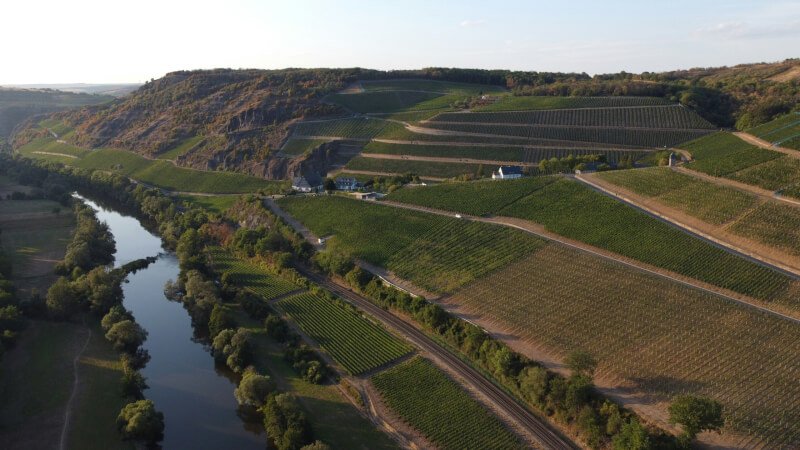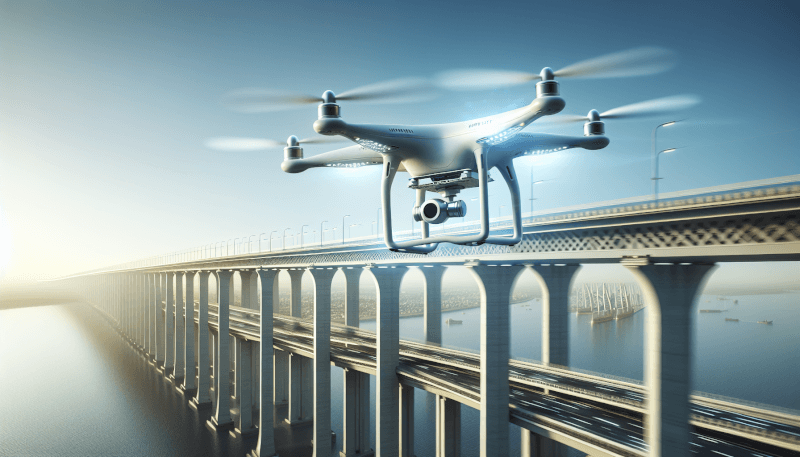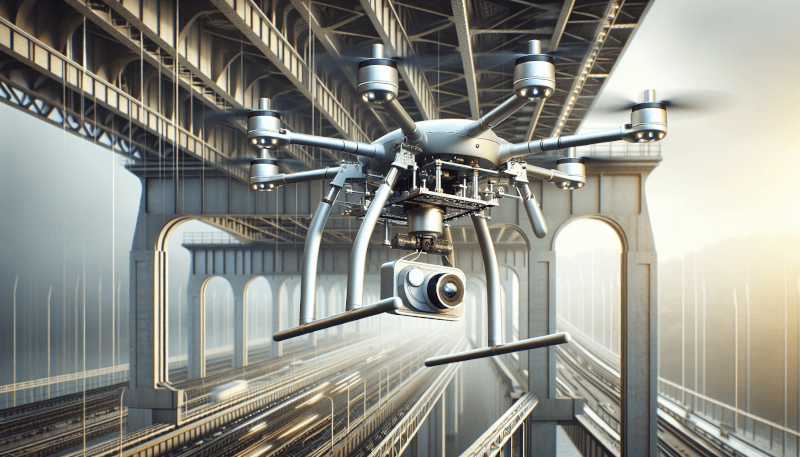Imagine being able to inspect and maintain infrastructure with ease, all thanks to the power of drones. In this article, we will explore the incredible benefits of utilizing drones for infrastructure inspection and maintenance. From their ability to reach inaccessible areas to their cost-effective and time-saving capabilities, drones are revolutionizing the way we monitor and care for our infrastructure. Get ready to discover a whole new world of possibilities as we delve into the exciting realm of drone technology.
Benefits of using drones for infrastructure inspection and maintenance
Drones have revolutionized the way infrastructure inspections and maintenance are conducted, offering numerous benefits over traditional methods. Firstly, drones provide a cost-effective and time-efficient solution. With drones, you can quickly and accurately inspect large areas in a short amount of time, reducing the need for manual inspections that can be labor-intensive and time-consuming. This efficiency translates to cost savings and increased productivity.
One of the most significant advantages of using drones for infrastructure inspection is the improved safety for workers. By deploying drones, you can eliminate the need for personnel to physically access hazardous or hard-to-reach areas. This not only minimizes the risk of workplace accidents but also protects workers from potential exposure to dangerous substances or environments. Drones can reach inaccessible areas such as tall structures and confined spaces, ensuring thorough inspections without endangering human lives.
Another benefit of using drones for infrastructure inspection and maintenance is the enhancement of data collection and analysis. Equipped with high-resolution cameras and sensors, drones can capture detailed imagery and videos of infrastructure elements. This data can then be processed and analyzed to identify flaws, deterioration, or any other issues that require attention. Furthermore, drones can also collect data in different formats, including LiDAR (Light Detection and Ranging), providing a comprehensive view of the infrastructure asset.
Additionally, drones enable access to hard-to-reach areas, which was previously challenging or impossible with traditional inspection methods. Infrastructure assets such as bridges, tall buildings, or communication towers often have intricate structures or inaccessible areas that are difficult for humans to reach. By utilizing drones, inspectors can easily navigate through these complex structures, providing a thorough assessment of the asset’s condition. This accessibility improves the overall quality and effectiveness of inspections.
Types of drones used for infrastructure inspection and maintenance
Different types of drones are used for infrastructure inspection and maintenance, each with its own unique capabilities and suitability for specific scenarios.
Multi-rotor drones
Multi-rotor drones, commonly known as quadcopters, are a popular choice for infrastructure inspections. These drones are equipped with multiple rotors that provide stability, maneuverability, and hovering capability. Multi-rotor drones offer a versatile solution suitable for inspections of various structures, such as buildings, bridges, and powerlines. They are typically equipped with high-resolution cameras and sensors to capture detailed imagery and collect data for analysis.
Fixed-wing drones
Fixed-wing drones are designed like miniature airplanes, with fixed wings that generate lift and allow for sustained flight. These drones are ideal for covering large areas and conducting aerial surveys. With longer flight times and higher speeds compared to multi-rotor drones, fixed-wing drones excel in wide-scale inspections, such as pipeline monitoring or assessing extensive road networks. They are equipped with advanced imaging sensors and can cover large distances efficiently.
Hybrid drones
Hybrid drones combine the best of both multi-rotor and fixed-wing drones, offering the advantages of vertical take-off and landing (VTOL) capability and long-range flights. These drones can transition between hover and forward flight, making them suitable for inspecting areas that require both close-up inspections and broader coverage. Hybrid drones are often used for inspecting complex structures like wind turbines, where a combination of vertical and horizontal movements is necessary.

Key considerations when choosing a drone for infrastructure inspection and maintenance
Selecting the right drone for infrastructure inspection and maintenance requires careful consideration of various factors. The following key considerations will help you make an informed decision.
Flight time and battery life
When choosing a drone, it is important to consider the flight time and battery life. Longer flight times are beneficial, as they allow for extended inspections without the need to recharge or replace batteries frequently. Understanding the drone’s battery life and the availability of spare batteries or quick charging options is essential to ensure uninterrupted operations and maximize inspection efficiency.
Payload capacity and sensors
The payload capacity of a drone determines its ability to carry additional equipment such as high-resolution cameras, LiDAR sensors, or thermal imaging systems. Depending on the specific inspection requirements, the drone should have enough payload capacity to accommodate the necessary sensors and cameras. Consider the weight and dimensions of the equipment you plan to use and ensure the drone can handle the payload without compromising flight stability or control.
Flight stability and control
Flight stability and control are crucial for conducting precise inspections. Look for drones with advanced stabilization systems and reliable flight control mechanisms. GPS and inertial navigation systems can greatly enhance stability and accuracy, allowing for smooth and controlled flight even in challenging conditions. Additionally, features such as obstacle avoidance and automated flight modes can further improve the ease of operation and safety during inspections.
Durability and weather resistance
Since infrastructure inspections often take place in various environmental conditions, it is important to choose a drone that is durable and weather-resistant. Ensure the drone is designed to withstand wind, rain, dust, and other elements that may be encountered during inspections. Look for drones with robust construction materials and sealed components to protect against water damage. This durability will contribute to the longevity of the drone and its ability to perform in diverse inspection scenarios.
Remote control and autonomous capabilities
Consider the control options available for the drone, as they can greatly impact the ease of operation and overall inspection efficiency. Most drones can be controlled remotely using dedicated controllers or mobile apps. Look for user-friendly interfaces that allow for intuitive control and monitoring of the drone’s flight and sensor data. Additionally, consider drones with autonomous features, such as waypoint navigation or automated inspection modes. These capabilities can streamline the inspection process and reduce the need for constant manual control.
Best practices for planning drone operations for infrastructure inspection and maintenance
To ensure successful and efficient drone operations for infrastructure inspection and maintenance, it is important to follow these best practices.
Identify inspection objectives and requirements
Before conducting any drone operations, clearly define the inspection objectives and requirements. Determine what specific aspects of the infrastructure you are inspecting and what information needs to be gathered. This will help you tailor your drone operations to suit the particular needs of the inspection and ensure that the collected data is relevant and useful.
Perform pre-flight checks and risk assessments
Prior to each flight, perform thorough pre-flight checks to ensure the drone is in optimal condition and all components are functioning properly. Inspect the drone’s physical condition, check battery levels, and verify that all sensors and cameras are operational. Additionally, conduct a risk assessment to identify any potential hazards or obstacles that may affect the flight. This evaluation will help you mitigate risks and ensure a safe and successful operation.
Obtain necessary permissions and permits
Drone operations for infrastructure inspection and maintenance may require permission from relevant authorities or property owners. Ensure you have the necessary permits and permissions before conducting any flights. Familiarize yourself with local regulations and airspace restrictions to avoid any legal issues or violations. Compliance with regulations will contribute to safe and responsible drone operations.
Plan flight routes and waypoints
Effective flight planning is essential for efficient inspections. Plan the flight routes and waypoints in advance to ensure complete coverage of the infrastructure asset. Consider the specific inspection objectives and the flight capabilities of the drone when designing the flight patterns. Take into account any restricted areas or no-fly zones to ensure compliance with regulations and safety protocols.
Establish communication protocols
Establish clear communication protocols between the drone operator and any ground personnel involved in the inspection process. This includes establishing communication frequencies, signal strength requirements, and emergency procedures. Effective communication will enhance coordination and ensure smooth cooperation during inspections.

Obtaining high-quality data during infrastructure inspections
To ensure high-quality data collection during infrastructure inspections, consider implementing the following techniques and practices.
Using high-resolution cameras and sensors
Equipping drones with high-resolution cameras and sensors is crucial for capturing detailed imagery and accurate data. High-resolution cameras allow for close-up inspections and provide clear visual documentation of any flaws or defects. Sensors such as LiDAR or thermal imaging systems can provide additional data and insights beyond what is visible to the naked eye. Invest in cutting-edge sensors and cameras to maximize the quality and usefulness of the collected data.
Implementing specialized imaging techniques (e.g., thermal imaging)
In certain cases, specialized imaging techniques can greatly enhance the effectiveness of infrastructure inspections. For example, thermal imaging can be used to identify heat anomalies on buildings or detect leaks in pipelines. Implementing these techniques requires drones equipped with the appropriate sensors and the expertise to interpret the captured data. Consider the specific needs of the inspection and explore specialized imaging techniques that may provide valuable insights.
Collecting data in different formats (images, videos, LiDAR)
When conducting infrastructure inspections, it is important to collect data in multiple formats. Images and videos provide valuable visual evidence of any defects or abnormalities. LiDAR data, on the other hand, can provide precise measurements and detailed 3D models of the infrastructure asset. Collecting data in different formats allows for a comprehensive and multi-dimensional analysis of the asset’s condition and facilitates accurate documentation for future reference.
Ensuring proper geotagging and metadata
Accurate geotagging and metadata are essential for organizing and analyzing the data collected by the drone. Geotagging involves associating GPS coordinates with each captured image or data point, allowing for precise location mapping and correlation with other data sets. Metadata includes additional information such as flight parameters, sensor settings, and environmental conditions. Proper geotagging and metadata ensure the reliability and traceability of the collected data, enabling effective analysis and reporting.
Analyzing and processing data collected by drones
The data collected by drones during infrastructure inspections can be processed and analyzed to extract valuable insights. Here are some key techniques and methods used in data analysis and processing.
Utilizing AI and machine learning algorithms
AI and machine learning algorithms can be leveraged to analyze the vast amount of data collected by drones quickly and accurately. These algorithms can detect patterns and anomalies in the data, identifying areas of concern or potential defects. For example, machine learning algorithms can be trained to identify cracks or corrosion on bridge structures. By utilizing AI and machine learning, inspectors can streamline the analysis process and focus their attention on critical issues.
Conducting advanced image and video analysis
Images and videos captured by drones can be subject to advanced analysis techniques to extract valuable information. Image processing algorithms can automatically detect and classify different objects or features, such as signs of degradation or damage. Video analysis can be used for real-time monitoring of infrastructure assets, enabling inspectors to identify changes or anomalies as they occur. Advanced image and video analysis techniques provide a more detailed and comprehensive understanding of the asset’s condition.
Creating 3D models and point clouds
By utilizing the collected data, drones can create highly accurate 3D models or point clouds of the inspected infrastructure. LiDAR data, combined with photogrammetry techniques, can generate detailed 3D representations of the asset. These models provide a more immersive and detailed view compared to traditional 2D images, enabling inspectors to analyze intricate structures and identify potential issues from multiple perspectives. 3D models and point clouds facilitate better visualization and enhance the precision of inspections.
Generating accurate and detailed reports
The data collected, processed, and analyzed by drones can be transformed into comprehensive reports. These reports should include detailed information on the asset’s condition, identified flaws or issues, and recommendations for further actions. By presenting the data in a clear and accessible manner, these reports become valuable tools for decision-making and planning future maintenance or repair activities. Accuracy and attention to detail are crucial when generating reports, as they serve as a vital resource for infrastructure management.

Challenges and limitations of using drones for infrastructure inspection and maintenance
While drones offer numerous benefits, there are certain challenges and limitations to consider when using them for infrastructure inspection and maintenance.
Adverse weather conditions
Unfavorable weather conditions, such as strong winds, heavy rain, or low visibility, can pose challenges to drone operations. Drones may struggle to maintain stability or navigate safely in adverse weather, compromising the quality of inspections. It is important to monitor weather conditions and reschedule drone operations if necessary to ensure the safety of the equipment and personnel involved.
Limited flight time and battery capacity
Most drones have limited flight times due to battery limitations. This can be a constraint when inspecting large or complex infrastructure assets that require prolonged flight durations. Operators need to carefully plan their flights to optimize the use of available battery life and ensure inspections are completed within the given time constraints. Additionally, having spare batteries or access to battery charging facilities is essential for uninterrupted operations.
Navigating complex structures and tight spaces
While drones excel in accessing hard-to-reach areas, navigating complex structures can still pose challenges. Tight spaces, narrow corridors, or intricate architectural features may require advanced piloting skills and techniques to conduct thorough inspections. Operators must be well-trained and experienced to maneuver the drone safely and effectively in these challenging environments.
Legal and regulatory restrictions
Drone operations for infrastructure inspection and maintenance are subject to various legal and regulatory restrictions. Flight restrictions, privacy concerns, and permits from authorities may impact the ability to conduct inspections in certain areas. It is vital to comply with these regulations to ensure the legality and legitimacy of the drone operations. Staying informed about the latest regulations and maintaining the necessary licenses and certifications is crucial for responsible and compliant drone use.
Potential risks of losing or damaging the drone
Operating drones for infrastructure inspection involves risks of losing or damaging the equipment. Accidents, collisions with obstacles, or technical failures can result in the loss or destruction of the drone. To mitigate these risks, operators should ensure they have proper insurance coverage and take necessary precautions, such as regular maintenance and inspections of the drone. Additionally, having backup equipment or access to repair services can minimize downtime and maintain continuity in inspection activities.
Training and certification requirements for drone operators
Drone operators involved in infrastructure inspection and maintenance need to meet certain training and certification requirements to ensure safe and efficient operations.
Obtaining necessary licenses and certifications
Drone operators must obtain the necessary licenses and certifications mandated by aviation authorities. These requirements can vary depending on the country or region, but commonly include obtaining a remote pilot license or commercial drone operator certification. These certifications typically involve passing knowledge tests covering aviation regulations, safety procedures, and aeronautical knowledge. Compliance with these licensing requirements is essential to operate drones legally and responsibly.
Gaining knowledge of aviation regulations and safety guidelines
In addition to licensing, drone operators must possess a comprehensive understanding of aviation regulations and safety guidelines. Knowledge of airspace restrictions, flight rules, and emergency procedures is crucial when conducting any drone operations. Familiarize yourself with local and national regulations governing drone operations and stay up to date with any changes or updates. Adhering to these regulations ensures the safety of the operation and the public.
Mastering drone flight and control skills
Proficiency in drone flight and control is critical for precision inspections. Drone operators must have excellent piloting skills to maneuver the drone safely and precisely, especially when navigating complex structures or tight spaces. Regular flight practice and training sessions are essential to maintain or improve these skills. Invest time in mastering flight techniques, understanding the drone’s capabilities, and practicing emergency procedures to ensure confident and reliable operations.
Understanding data collection and analysis techniques
Drone operators should have a good understanding of data collection and analysis techniques relevant to infrastructure inspections. Familiarity with different types of sensors, cameras, and imaging techniques allows operators to optimize data collection for accurate and meaningful analysis. Additionally, knowledge of data processing software and analysis tools provides operators with the ability to extract valuable insights from the collected data. Training and self-education in these areas contribute to the overall effectiveness and efficiency of drone inspections.

Case studies and success stories of drone applications in infrastructure inspection and maintenance
Drones have been successfully applied in various infrastructure inspection and maintenance scenarios, showcasing their practicality and effectiveness. Here are several case studies highlighting the benefits and outcomes of using drones in different contexts.
Bridge inspection and structural monitoring
Using drones for bridge inspections has become a popular application due to the significant time and cost savings they offer. Drones equipped with high-resolution cameras and LiDAR sensors can capture detailed imagery and collect data on bridge structures. This data can then be processed to detect signs of deterioration, potential weak points, or structural abnormalities. By employing drones, inspectors can efficiently assess the condition of bridges, identify maintenance needs, and plan necessary repairs or preventive measures.
Pipeline and powerline inspection
Closely monitoring pipelines and powerlines is crucial for ensuring their integrity and uninterrupted operation. Drones equipped with thermal imaging cameras or LiDAR sensors can detect leaks, corrosion, or vegetation encroachment in a non-intrusive and efficient manner. These inspections can be conducted without shutting down the pipelines or powerlines, minimizing disruptions and reducing inspection costs. Drones enable inspectors to cover extensive pipeline networks or powerline routes quickly and accurately, ensuring timely maintenance or repairs.
Roof and building inspections
Conducting roof and building inspections can be challenging and time-consuming when relying on manual methods. By employing drones, inspectors can gain access to rooftops and facades without the need for scaffolding or elevated platforms. Drones with high-resolution cameras can capture detailed imagery of roofs and building structures, detecting damaged or deteriorated areas. This allows for timely repairs and prolongs the lifespan of the building. The efficiency and cost-effectiveness of drone inspections make them an ideal solution for routine or periodic building assessments.
Wind turbine and solar panel inspections
Regular inspections of wind turbines and solar panels are essential to ensure their optimal performance. Drones equipped with specialized sensors and cameras can inspect these structures quickly and accurately. By capturing high-resolution images or thermal data, drones can identify faulty or damaged components, identify potential areas of energy loss, and monitor the overall condition of the turbines or panels. Drones streamline the inspection process and minimize the need for manual, labor-intensive inspections at height, improving safety and reducing costs.
Railway and road infrastructure assessments
Drones offer significant advantages in inspecting railway tracks and road infrastructure. Traditional inspections often require manual inspections that may disrupt traffic or pose risks to workers. Drones can efficiently cover large lengths of tracks or extensive road networks, providing detailed imagery and data on the condition of the infrastructure. Inspectors can identify cracks, uneven surfaces, or other defects that may affect safety or maintenance requirements. By leveraging drones, railway companies and road authorities can plan targeted maintenance activities, reducing expenses and ensuring the safety and efficiency of transportation systems.
Future trends and advancements in drone technology for infrastructure inspection and maintenance
As drone technology continues to advance, several promising trends and advancements are shaping the future of infrastructure inspection and maintenance.
Integration of AI and machine learning for real-time analysis
Advancements in AI and machine learning are enabling drones to analyze data in real-time, allowing for immediate detection and notification of potential issues during inspections. Drones equipped with onboard processing capabilities and AI algorithms can identify defects, anomalies, or signs of deterioration autonomously. This real-time analysis minimizes the time between data collection and action, enabling faster response to maintenance needs and ensuring the safety and reliability of the infrastructure.
Enhancement of sensor capabilities (e.g., increased resolution)
Sensor technology is constantly evolving, with continuous improvements in resolution, accuracy, and functionality. Higher-resolution cameras provide more detailed imagery, allowing for more accurate inspections and assessments. Additionally, sensor capabilities such as thermal imaging and multispectral imaging are becoming more advanced, enabling drones to capture and analyze data beyond what is visible to the human eye. Enhanced sensor capabilities enhance the quality of data collection, enabling more precise and comprehensive inspections.
Extended flight time and improved battery technology
The limitations of flight time and battery capacity are currently being addressed through advancements in battery technology and energy efficiency. Longer flight times and improved battery life allow drones to perform longer inspections without interruption or the need for frequent battery changes. This opens up opportunities for conducting more extensive surveys, covering larger areas, and exploring challenging or remote locations. Enhanced battery technology will also support the integration of additional sensors and equipment, further enhancing the capabilities of drones for infrastructure inspections.
Development of autonomous and swarm drone systems
Autonomous and swarm drone systems are being developed to handle complex inspections with improved efficiency and coverage. Autonomous drones are capable of performing inspections without direct human control, following pre-defined flight paths and executing predefined inspection routines. Swarm drone systems involve multiple drones collaborating and sharing tasks to cover larger areas quickly and efficiently. These advanced systems reduce the workload of individual operators, increase inspection speed, and enhance the data collection capabilities of drones.
The future of drone technology in infrastructure inspection and maintenance looks promising. By embracing these trends and advancements, organizations can optimize their inspection processes, improve safety, and maintain critical infrastructure assets with greater accuracy and efficiency.



